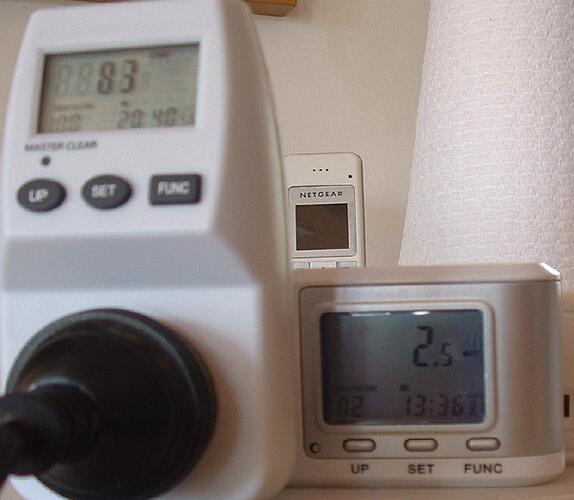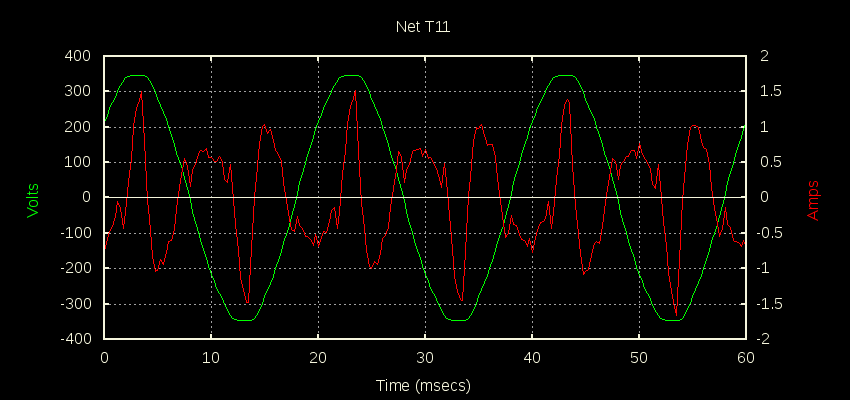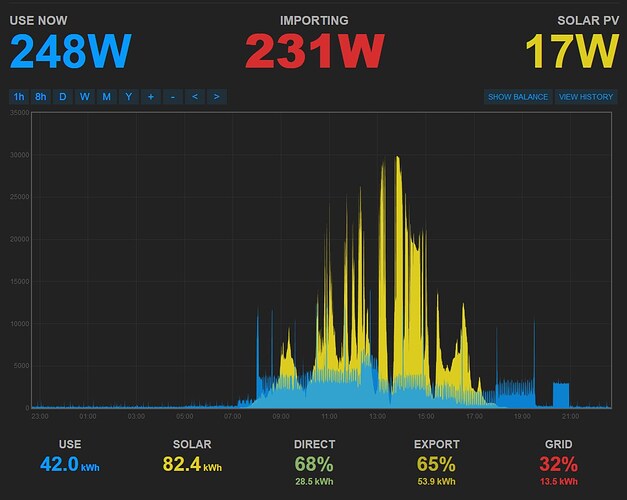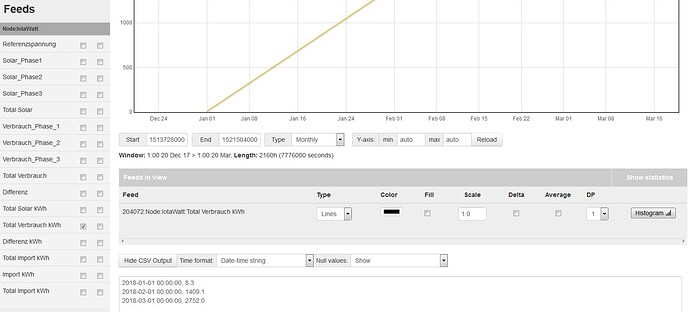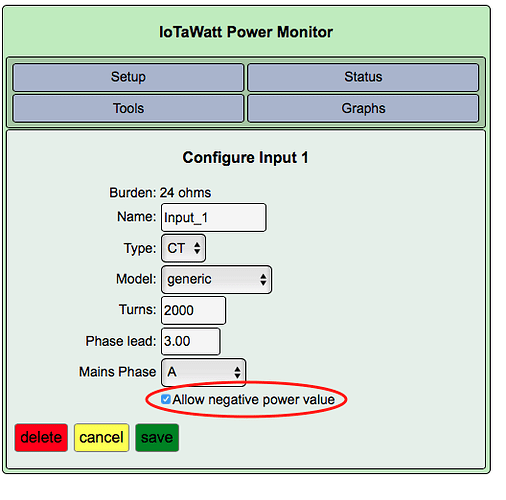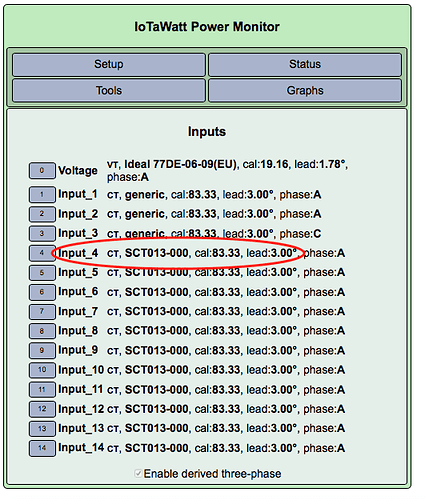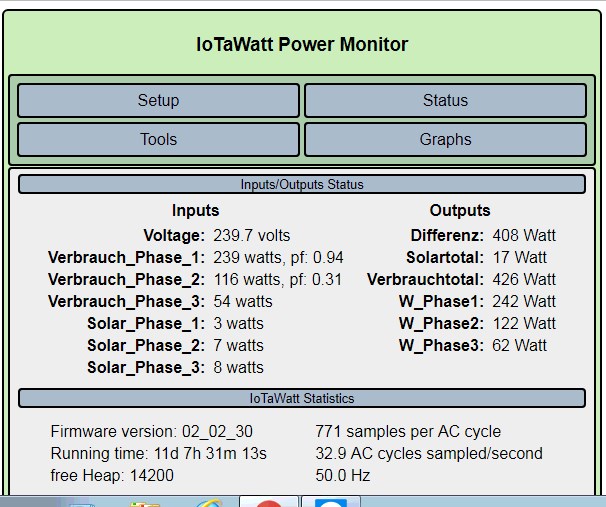Yeh, that particular signal really confuses some of the cheaper plug-through power monitors. In this photo you can see the $30 meter reckons it’s 2.5W with a PF of 0.2 while the $20 meter reckons it’s 83W with a PF of 1. What a difference $10 makes!
wow, thats great to see - and understand why in practice!
So let me see if I understand what you are saying. Lets say I “drill” down and set up monitoring on a single load, like an inverter mini-split heat pump that has a power factor of .90 in high output and about .80 during defrost and low output periods. Are you saying that I will get different results if I don’t account for the phase difference between a solid core CT with a phase shift of say 0.4° and a clamp on that has a phase shift of say 3° at the 4A-5A typical load of the heat pump? If so, how significant would you expect that difference to be?
It’s impossible to predict with that level of detail. Significantly (and perhaps unintuitively), the power factor of a load is not an indication of how sensitive the load measurement will be to introduced phase errors. The detail that’s missing is the phase of the fundamental (50Hz for me, 60Hz for you) component of the current signal (relative to V). If that’s close to 0° then the measurement will be quite insensitive to introduced phase errors (just like a big fat unity power factor resistive load is). If it’s a long way from 0° like in the two examples above, then it will be quite sensitive.
I’ve previously said it makes no sense to talk about phase when you’re dealing with non-sinusoidal signals, and then went ahead and broke my own rule in the two examples above by declaring the phase differences to be ~90° and ~50°, although I did include a caveat: “but they’re close enough [to a sinewave] that you could at least imagine what the 50Hz component would look like were you to extract it.” I eyeballed an FFT out of the signal. In the Microwave case it didn’t take much imagination at all, the Pool case is a little more challenging. Actually, I cheated a little in that case and asked my energy IC what it made of the signal… it calculated the fundamental phase difference to be 52.3°. There are some signals that I would never even attempt to guess at. Here’s a signal that my energy monitor (and my revenue meter) has to deal with at least twice a day:
That one doesn’t even require drilling down to a per-circuit basis. That’s what your main feed from the street to the house will look like if you’ve got solar panels and the solar panel output is roughly balanced with the house loads. That happens just after dawn and just before dusk every day, and quite a bit throughout the day on the cloudy days.
In summary, there are two pretty-much unrelated causes for non-unity power factors:
- a phase shift between V and I
- harmonics in I (i.e. non-sinusoidal I)
and typically you’ll have contributions from both. It’s the contributions from the first that determine how sensitive your measurement will be to introduced phase errors.
To demonstrate here’s a simple experiment you can try in a spreadsheet: knock up the standard single cycle V and I columns, in-phase perfect sinewaves, say 240V and 1A. Observe how both Apparent Power and Real Power come out at 240W and that the PF is 1. Play around with rotating one of the columns south by a cell or two (introducing a measurement phase error) and note how insensitive the Real Power calculation is to the phase error.
Now add a 10A 150Hz in-phase sinewave into the I column such that the I column is now the sum of a 1A 50Hz sinewave and a 10A 150Hz sinewave. Irms will be totally dominated by the 10A. Apparent power will shoot up to 2412 watts, Real Power will remain unchanged at 240W and power factor will drop down to 0.1. Again play around with moving a column south by a cell or two to introduce a measurement phase error and note how insensitive the calculation is to the error. So in this ridiculously extreme example, we’ve got an extremely low power factor but the Real Power measurement is just as robust as a unity power factor resistive load, when it comes to introduced phase errors.
BTW, this example also shows why it makes no sense to speak of angles when your non-unity power factor is caused by harmonics in I. You could calculate arccos(Real/Apparent) and you’d get 84° but there are no sinewaves here that are shifted by 84°. All the sinewaves in this experiment are in perfect phase with each other. The 84° is meaningless. It’s even a bit misleading, because it might tempt you to think: if the sinewaves are already out by 84° then this measurement is going to be very sensitive to any introduced phase errors. In reality, this measurement is extremely insensitive to introduced phase errors, because the sinewaves are in perfect sync with each other (and the power factor is very very low).
The actual kWh which your meter from the company counted and the kWh which the iota watt counted in the same period.
I also would like to know if your solar inverter is connected three phase or only on one phase and if on one, which?
Your 3-phase configuration is not quite correct, because you removed the phase lead for the current transformer. Instead of adding 240° to the second phase, it should be something around -120° + 3° phase shift = -117°. But you don’t have to worry about the numbers any more, just enable the derived three phase setup on the input page and choose phase B for the second and phase C for the third phase.
Solar are 3 converters, each with 3 phases, coupled to the 3 phases. Below the numbers from today from the solar converters:
And here the same reading from emoncms:
Can you explain me this calculation? Thanks.
Wow, the solar energy does fit perfectly!
Just a thought: Are the solar inverters configured to use the solar energy as self consumption and only are feeding the energy which you are not using into the grid? Could it be that the iotawatt is partly also measuring the solar energy which you are directly using?
Your Iotawatt would in this case measure your real consumption and your official energy meter only the kWh you imported additional from the grid.
As you apply the correction to the current input, you actually would have to subtract -120 degrees to match the current on the second phase with the voltage signal on the first phase. But in practice it’s pretty much the same like adding 240 degrees. The 3° are the phase shift for the current transformer, which you did not take into account. I assumed you are using the 100A CT’s.
To be save with the numbers, use the new setting at the input page for a derived three phase setup.
No, the SCT13 are direct before the energymeter from the power company.
Where can I get this 3° shift factor and if it is plus or minus?
Ok, I think I still have not quite understood your setup. What kind of energy meter is it? Does it also count the exported solar energy (two way meter)? In the case of exporting energy the power would be negative, is that the case? Is the IoTaWatt configured to measure negative numbers?
Can you please share some more details about that current transformer, please?
Is it a CT connected to IotaWatt?
For clarification: An old picture with the predecessor of IotaWatt.
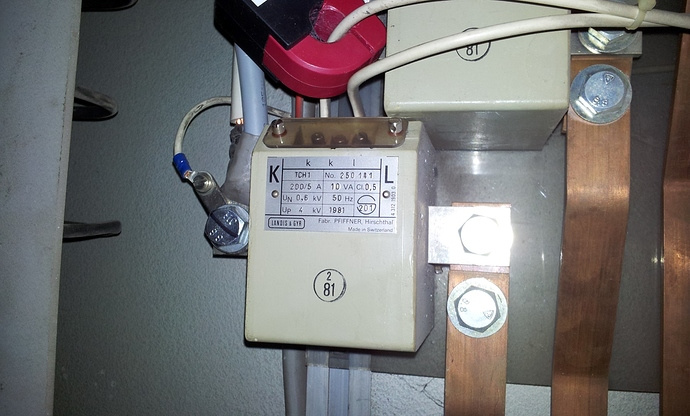
And here an other explanation:
You can’t see the 3 CT’s from solar, they are clipsed close to the meter (higher up).
This is the old configuration, it gave me a good result on solar but I was not able to get a predictable value on ‘use’.
On the actual configutation I clipsed the CT’s to the main line. Now I have to make a calculation for ‘use’ as ‘solar’ and ‘use’ are on the same lines.
And the status, it’s middle of the night, no sun.
I have to wait for results to compare it with the meter.
Thanks, now I got it. But I think it doesn’t make sence to split it into an other forum. I hope that’s o.K.
Thanks for the pictures, that makes it a bit clearer. So you are measuring the secondary current of the installed 200/5A current transformer. Are these current transformers used for the official meter from the electricity company or for what purpose are they? If not where is the officially meter located?
It looks like Solar and Mains are connected together just before the current transformer which are measuring the consumption of the users, is it correct?
If you have 100 A YHDC c.t’s on the secondary circuit of a 5 A c.t, you must expect the result to be not accurate. Although the YHDC does work below 5 A, the accuracy is not specified below 5 A and the errors will increase significantly as the current gets smaller.
Unfortunately, I cannot think of a 5 A primary split-core c.t. that I can recommend. The best I can think of is a Wattcore WC1 25 A : 100 mA, which will give you 20 mA (40% of full scale for an emonTx or emonPi) at 5 A:
This perhaps? (Magnelab)
100A:5A also available in 200 and 300 Amp versions. Wire window is 0.94 inches
The SCT006 from the shop should also be good as long as the secondary current does not go higher than 16 A, or not?
Or if possible, it would probably be better to skip the current transformer at all and meausure with 200A CTs on the primary side: 200A max clip-on current sensor CT - Shop | OpenEnergyMonitor
